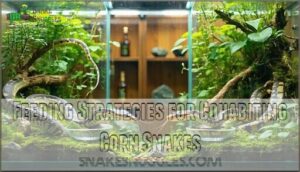This site is supported by our readers. We may earn a commission, at no cost to you, if you purchase through links.
 You shouldn’t house two corn snakes together.
You shouldn’t house two corn snakes together.
While it’s technically possible, these naturally solitary creatures experience significant stress when cohabiting, which can lead to aggression, cannibalism, and disease transmission.
Corn snakes avoid each other in the wild except during brief spring mating periods, preferring isolated territories where they can hunt and hide without competition.
Even with a large enclosure and multiple hiding spots, the risks outweigh any benefits.
Individual housing allows you to monitor each snake’s health, feeding habits, and behavior more effectively while supporting their authentic nature.
There are specific setup requirements and warning signs that every corn snake owner should understand.
Table Of Contents
- Key Takeaways
- Natural Behavior of Corn Snakes in The Wild
- Benefits of Housing Corn Snakes Separately
- Risks of Cohabitation for Corn Snakes
- Exceptions for Breeding Corn Snakes Together
- Space Requirements for Multiple Corn Snakes
- Creating Separate Territories Within One Enclosure
- Feeding Strategies for Cohabiting Corn Snakes
- Signs of Stress in Cohabiting Corn Snakes
- Alternative Housing Solutions for Multiple Corn Snakes
- Frequently Asked Questions (FAQs)
- Can two corn snakes live together?
- Should you keep two corn snakes in the same vivarium?
- Can two snakes live together?
- Can king snakes live together?
- Do corn snakes live alone?
- Can two corn snakes be kept in the same cage?
- Can two corn snakes live in the same tank?
- Do corn snakes do well in pairs?
- How many corn snakes can be kept together?
- Can adult corn snakes live together?
- Conclusion
Key Takeaways
- Don’t house corn snakes together – they’re naturally solitary creatures who experience significant stress, aggression, and health risks when cohabiting, even with adequate space and hiding spots.
- Cohabitation creates serious dangers – you’ll face risks of cannibalism, disease transmission, feeding competition, and difficulty monitoring each snake’s individual health and behavior.
- Individual housing is always safer – separate enclosures allow you to track feeding habits, spot health issues early, and provide proper care without territorial conflicts or stress.
- Breeding is the only exception – temporarily house pairs together only during the spring mating season for 10-14 days maximum, then separate immediately to prevent aggression and cannibalism.
Natural Behavior of Corn Snakes in The Wild
Understanding your corn snake’s wild behavior helps you make better housing decisions for your pet. In nature, these snakes live completely alone except during brief mating periods each spring.
Solitary Nature of Corn Snakes
Corn snakes break away from the pack and live completely alone in their natural habitat.
In the wild, these adaptable serpents choose solitude over companionship for their entire lives
These natural instincts make them stress-free solo dwellers who actively avoid other snakes except during breeding season.
Their wild habits show clear solitary behavior.
What snake isolation means for your pet:
- Peace of mind – No constant territorial disputes
- Natural comfort – Living according to their wild habits
- Reduced anxiety – Snake stress disappears when alone
- Authentic behavior – Natural instincts shine through
- Healthier life – Cohabiting goes against their core nature
Understanding their snake behavior patterns is essential for providing a suitable environment.
Mating Habits and Seasonal Interactions
When do corn snakes get together? Only during breeding season, which typically occurs in spring.
Males seek out females through scent trails and engage in snake courtship rituals.
After mating, pairs separate immediately – females lay eggs independently while males move on.
This brief breeding cycle proves corn snakes naturally prefer solitary lives, making cohabiting challenging year-round.
Benefits of Housing Corn Snakes Separately
Housing corn snakes separately aligns with their natural solitary instincts and provides significant advantages for both you and your pets.
You’ll find it much easier to monitor each snake’s health, feeding habits, and behavior when they’re not competing for your attention or resources, which supports their overall health.
Reduced Stress for Snakes
Housing your snake alone dramatically reduces stress levels compared to cohabiting arrangements.
When corn snakes share space, they experience constant anxiety from territorial conflicts and competition.
Key stress reduction benefits include:
- Peace of mind – Your snake won’t worry about defending territory
- Natural comfort – Solitary housing matches their wild instincts perfectly
- Better sleep – No disturbances from cage mates during rest periods
Single enclosure design supports ideal snake welfare through stress reduction.
Easier Monitoring of Health
When you house snakes separately, tracking individual health becomes straightforward.
You’ll easily spot changes in feeding habits, monitor parasite control measures, and schedule regular health checks without confusion.
Snake isolation prevents disease transmission while allowing focused medical care.
Each snake’s appetite, behavior, and physical condition stays visible, making disease prevention and early parasite detection much simpler for responsible owners.
Prevents Potential Aggression Issues
Aggression between cohabiting corn snakes can escalate quickly, even in seemingly peaceful pairs.
Snake fighting often starts with subtle aggression signs like excessive hiding or territorial posturing.
Solo housing eliminates these conflict prevention challenges entirely.
You’ll avoid the stress of monitoring snake social behavior and wondering "can corn snakes live together" safely.
Stress reduction comes naturally when housing multiple snakes separately.
Risks of Cohabitation for Corn Snakes
Despite their docile appearance, housing two corn snakes together can create serious problems you mightn’t expect.
From territorial disputes to life-threatening health risks, cohabitation challenges your snakes’ natural instincts and puts their wellbeing at stake.
Stress and Aggression Between Snakes
When cohabiting corn snakes, you’ll witness Snake Conflict emerge from Social Hierarchy establishment.
Stress Factors include resource competition and Territorial Defense behaviors.
- Your snakes may engage in intimidating standoffs over prime hiding spots
- One snake could dominate feeding areas, leaving the other hungry and stressed
- Aggression escalates when snakes feel their territory is invaded
Aggression Triggers manifest through chasing, striking, or defensive posturing between snakes.
Chronic stress weakens immune systems, making your pets vulnerable to illness
Recognizing stress signals is essential to prevent long-term health issues in cohabiting corn snakes.
Potential for Cannibalism
Beyond feeding battles, you’re facing a scarier reality: cannibalism risk.
Corn snakes are opportunistic cannibals who’ll eat smaller tankmates, especially during feeding competition. Size differences trigger these aggressive attacks, with larger snakes viewing smaller ones as prey.
Even similarly-sized cohabiting corn snakes can turn cannibalistic when hunger strikes, making separate housing the safest choice.
To minimize risks, this is vital: understand communal housing risks and take necessary precautions.
Increased Risk of Disease Transmission
When snakes share a vivarium, you’re creating a perfect storm for Disease Spread.
One infected snake transforms your enclosure into a transmission highway, spreading illness faster than you’d expect.
- Shared water bowls become contaminated with bacteria and viruses, creating ongoing Infection Control challenges
- Stress-weakened immune systems make cohabiting snakes vulnerable to Parasite Risk and respiratory infections
- Direct contact allows mites, scale rot, and other Snake Health Issues to jump between animals instantly
- Asymptomatic carriers can spread disease for weeks before you notice symptoms, making Health Monitoring nearly impossible
Difficulty Monitoring Individual Health and Feeding
Beyond disease concerns, tracking each snake’s wellbeing becomes nearly impossible.
You can’t tell who’s eating, losing weight, or showing early illness signs.
Individual Monitoring suffers when Feeding Multiple Corn Snakes share space.
Separate Feeding Areas help, but Health Risks from poor Snake Nutrition persist.
Feeding Schedules get messy, and Cannibalism in Snakes increases when you can’t monitor properly.
Keeping Multiple Corn Snakes means constant guesswork about Snake Health Issues and Feeding Challenges.
Exceptions for Breeding Corn Snakes Together
While corn snakes are naturally solitary creatures, there’s one important exception when temporary cohabitation becomes necessary.
You’ll need to house breeding pairs together for short periods during mating season, typically lasting just a few days to weeks before separating them again.
Temporary Cohabitation During Mating Season
Breeding season brings unique considerations for corn snake pairs. During this window, temporary housing becomes necessary for successful mating strategies and breeding cycles.
- Snake introductions require careful supervision during initial contact periods
- Temporary housing should last only 12-48 hours maximum for safety
- Mating outcomes depend on proper environmental cues and timing
- Cannibalism in snakes risks increase without constant monitoring during cohabiting
The instructions provided for breeding corn snakes emphasize the importance of careful planning and supervision to ensure successful mating and to minimize risks such as cannibalism.
Proper Timing and Duration for Breeding Pairs
Timing your breeding corn snakes requires patience and precision.
Mating season runs from March through May when breeding cycles naturally peak.
Introduce your corn snake pairs for 10-14 days maximum during this window.
This timeframe allows proper courtship behavior and pair bonding while preventing stress.
Breeding success depends on respecting these natural rhythms rather than forcing cohabiting outside ideal periods.
Monitoring and Separating After Successful Mating
Monitoring your breeding pair becomes vital once mating concludes.
You’ll need to watch for pregnancy signs and separate them quickly to prevent stress and potential aggression.
Here’s what to watch for:
- Behavioral changes – Your female may become more reclusive or defensive after successful mating
- Physical signs – Look for increased appetite and gradual body thickening indicating egg development
- Timing matters – Separate within days of confirmed mating to avoid cannibalism risks during vulnerable periods
Post mating care requires immediate snake separation since cohabiting after breeding can trigger aggressive snake social interaction.
Proper mating surveillance helps guarantee positive breeding outcomes while protecting both snakes from harm.
Space Requirements for Multiple Corn Snakes
When you’re thinking about housing multiple corn snakes together, space becomes your biggest concern since these naturally solitary animals need room to avoid each other.
You’ll need substantially more space than just doubling a single snake’s enclosure to prevent territorial conflicts and stress-related health problems.
Minimum Enclosure Size for Single Snakes
Your single corn snake needs proper space to thrive. Start with a 20-gallon long tank for juveniles, upgrading to 40 gallons for adults.
Enclosure depth should match your snake length – aim for two-thirds of their body size. Tank volume matters less than floor space for these ground-dwellers.
Proper snake enclosures require adequate heating requirements and ventilation needs. Quality vivariums support healthy corn snake care through appropriate enclosure size and thoughtful reptile housing design.
For suitable snake care, consider a suitable 20 gallon tank to guarantee your pet’s well-being.
Additional Space Needed for Multiple Snakes
Housing multiple corn snakes requires at least 120 gallons for two adults—double the single snake minimum.
Enclosure size matters because snake density affects stress levels. You’ll need 50% more space than their combined requirements to prevent territorial disputes.
Larger snake enclosures allow proper corn snake compatibility by providing separate zones for each snake’s comfort.
Proper temperature gradient management is essential for the well-being of the snakes in a shared enclosure.
Importance of Vertical and Horizontal Space
Your corn snakes need both horizontal and vertical space for healthy cohabiting.
Proper vivarium design prevents territorial conflicts when keeping multiple corn snakes together.
- Horizontal expansion gives each snake separate territories and reduces stress
- Vertical climbing opportunities with branches satisfy natural behaviors
- Enclosure layout with multiple levels maximizes space allocation efficiently
Thoughtful vivarium setup guarantees corn snake compatibility.
Creating Separate Territories Within One Enclosure
If you’re determined to house two corn snakes together, you’ll need to create distinct territories within the enclosure to minimize conflicts.
This means providing multiple hiding spots, basking areas, and visual barriers so each snake can establish its own space without constant interaction, allowing for the creation of separate areas that promote a sense of territories.
Multiple Hiding Spots and Basking Areas
Establishing multiple territories through strategic Hiding Spot Design and Basking Area Temperature zones helps minimize conflicts in Cohabiting scenarios.
Create separate areas with proper Vertical Space Usage and varied Enclosure Decoration.
Your Vivarium Setup should include distinct hiding spots and basking areas to accommodate Multiple Corn Snakes while respecting natural Snake Behavior patterns within shared Enclosures.
Proper snake enclosure design is essential for the health and well-being of the snakes.
Visual Barriers and Dividers
Beyond multiple hiding spots, you’ll need Screen Walls or Divider Panels to block sight lines between cohabiting snakes.
Visual Blocks help reduce stress in your Vivarium Setup by mimicking natural boundaries.
- Barrier Materials: Install mesh screens or solid partitions to create separate zones
- Hide Boxes: Position additional shelters near Visual Blocks for enhanced security
- Enclosures Design: Use plants or decorative elements as natural dividers for Multiple Corn Snakes
Maintaining Proper Temperature Gradients for Each Snake
Several thermal zones prevent competition and guarantee each corn snake can thermoregulate properly.
Create multiple temperature gradients using separate heat sources – ceramic emitters for basking spots (88-92°F) and heat mats for warm zones (75-82°F).
Install digital thermometers in each snake’s territory to monitor gradient maintenance accurately.
Position hiding spots in both warm and cool areas so neither snake monopolizes preferred temperatures, preventing thermal stress and supporting healthy snake enclosure setup.
To achieve superior results, consider the temperature humidity controls for a well-designed enclosure, ensuring a proper enclosure setup with adequate temperature gradients.
Feeding Strategies for Cohabiting Corn Snakes
When you’re housing two corn snakes together, feeding becomes your biggest challenge since these solitary hunters can turn aggressive around food.
You’ll need to separate them completely during meals to prevent fights, injuries, or even cannibalism between your snakes, as these situations can arise from the snakes’ natural behavior of being solitary hunters.
Separate Feeding Areas or Containers
When Feeding Time arrives, you’ll need Separate Feeding Areas to prevent territorial disputes.
Use Feeding Containers or Isolation Boxes away from the main enclosure. Feeding Trays work well for creating distinct Food Separation zones.
Consider Snake Feeders that allow individual access. This Snake Enclosure Setup reduces competition stress when Keeping Multiple Corn Snakes together safely.
Implementing a separate feeding routine is essential for maintaining a healthy environment.
Monitoring Individual Food Intake
After establishing separate feeding areas, you’ll need to track each snake’s food intake carefully. Individual nutrition monitoring helps you spot health problems early and guarantees both snakes get proper meals.
Think of it like keeping a diary for each snake’s eating habits. Without proper food tracking, you might miss warning signs or accidentally overfeed one snake while the other goes hungry.
Here’s what successful intake monitoring looks like:
- Keep detailed feeding logs with dates, prey sizes, and which snake ate what
- Weigh each snake monthly to track healthy growth patterns and catch issues early
- Document meal schedules to guarantee consistent feeding intervals for both snakes
- Record feeding behavior noting appetite changes or unusual eating patterns
- Create separate nutrition plans based on each snake’s age, size, and individual needs
This systematic approach to feeding multiple snakes prevents malnutrition and helps you maintain accurate health records for veterinary visits.
Preventing Food-related Aggression
Most feeding incidents escalate quickly when corn snakes compete for the same meal. Food Competition creates dangerous situations where Aggression Triggers activate instantly.
Your best Feeding Strategies involve Snake Isolation during mealtimes for effective Stress Reduction.
| Risk Factor | Prevention Method |
|---|---|
| Food Competition | Separate feeding containers |
| Aggression between snakes | Feed in different rooms |
| Cannibalism risk | Monitor size differences |
| Feeding frenzy | Use feeding tongs |
| Territory disputes | Remove after eating |
Keeping Multiple Corn Snakes requires understanding Snake Behavior patterns that emerge during Feeding Multiple Snakes scenarios.
Signs of Stress in Cohabiting Corn Snakes
Recognizing stress in cohabiting corn snakes is essential for their health and wellbeing.
You’ll need to watch for specific behavioral and physical changes that indicate your snakes aren’t comfortable sharing space, which can be a key factor in recognizing stress.
Changes in Behavior or Activity Levels
Watch for these warning signs that stress is affecting your corn snakes’ well-being when housed together:
- Excessive tongue flicking and rapid, jerky movements throughout the day
- Disrupted sleep cycles with unusual nocturnal activity replacing normal daytime basking
- Reduced exploration as stressed snakes avoid moving around their enclosure
- Persistent escape attempts like nose rubbing against glass or frantic climbing
- Defensive postures including increased hissing and body flattening when approached
These behavioral shifts signal your snakes aren’t adapting well to cohabitation.
Loss of Appetite or Weight
When appetite loss strikes your cohabiting corn snakes, it’s often stress signaling trouble ahead.
Weight decline typically follows feeding issues, creating serious snake malnutrition concerns.
Aggression between snakes can trigger starvation risks, while cannibalism threats loom when one snake appears weaker.
Possible Causes Actions to Take
Visible Injuries or Scale Damage
Physical injuries reveal the harsh reality of cohabitation stress. Scale damage appears as scratches, bite marks, or raw patches where snakes have clashed.
Inspect wounds carefully for infection signs and provide immediate wound care. Multiple corn snakes competing for space often results in aggression and cannibalism attempts, causing visible skin lesions requiring prompt attention.
- Your snake’s torn scales tell a story of invisible territorial battles
- Fresh bite marks mean one snake saw the other as prey, not a roommate
- Damaged skin opens the door to serious snake diseases and infections
Hiding Excessively or Unusual Positioning
Beyond physical injuries, cohabiting corn snakes display concerning hiding behavior and unusual posture when stressed. Excessive hiding means they’ll rarely emerge, even for basic activities like thermoregulation.
Watch for these snake stress indicators in your vivarium:
- Staying hidden during normal basking hours
- Positioning themselves in corners or against walls constantly
- Avoiding open areas they previously used
- Remaining motionless for extended periods
- Displaying defensive body language when approached
Abnormal positioning often signals aggression or fear between cohabiting corn snakes, potentially escalating to cannibalism.
Alternative Housing Solutions for Multiple Corn Snakes
If you can’t house your corn snakes together but still want multiple pets, you have several smart alternatives that keep everyone safe and stress-free.
These solutions let you enjoy multiple snakes while respecting their natural need for personal space and allowing you to keep everyone stress-free.
Separate but Adjacent Enclosures
Separate enclosures placed side by side offer the best compromise for keeping multiple corn snakes.
Adjacent enclosures let you monitor both snakes easily while preventing aggression and stress. Each snake gets its own space, food, and territory without shared walls creating competition.
The use of adjacent tanks requires careful consideration of tank setup designs.
| Housing Method | Safety Level | Care Difficulty |
|---|---|---|
| Adjacent Enclosures | High | Low |
| Shared Vivarium | Low | High |
| Dual Habitats | Medium | Medium |
This proximal housing setup works perfectly for corn snake owners wanting individualized care without the headaches of cohabitation conflicts.
Rotating Snakes Between Enclosures
Rotating corn snakes between enclosures offers fresh environments without cohabitation risks.
This Snake Rotation strategy supports Snake Health through environmental enrichment while maintaining proper Snake Housing practices.
Rotation Schedules should follow these guidelines:
- Switch Corn Snakes every 2-4 weeks to prevent stress
- Clean each Vivarium thoroughly between rotations
- Monitor for signs of Aggression or territorial marking
- Maintain consistent temperatures across all habitats
- Document feeding and behavior patterns during Habitat Switching
Proper Enclosure Management prevents Cannibalism while providing mental stimulation through new scents and layouts.
Creating a Multi-level Habitat System
A multi-level habitat system maximizes vertical space for multiple corn snakes while maintaining separate territories.
You’ll create stacked vivarium levels with individual hide boxes, climbing structures, and thermal gradients on each tier.
This snake housing approach reduces direct contact between reptiles while offering enrichment.
However, keeping multiple corn snakes together still carries risks despite innovative reptile enclosures design features, including the use of thermal gradients.
Frequently Asked Questions (FAQs)
Can two corn snakes live together?
You shouldn’t house two corn snakes together since they’re naturally solitary creatures. Cohabitation increases risks of cannibalism, aggression, disease transmission, and feeding competition, creating unnecessary stress for both snakes.
Should you keep two corn snakes in the same vivarium?
You shouldn’t keep two corn snakes together in one vivarium. They’re naturally solitary animals that become stressed, aggressive, and may even eat each other when housed together.
Can two snakes live together?
Wild corn snakes live solitary lives, avoiding contact except during mating.
You shouldn’t house two together because they’ll compete aggressively for food, risk cannibalism, and spread diseases quickly in shared spaces.
Can king snakes live together?
King snakes shouldn’t live together since they’re naturally cannibalistic and will eat other snakes, including their own species.
You’ll risk losing one snake to the other, even if they’re similar sizes.
Do corn snakes live alone?
Yes, corn snakes naturally live alone in the wild and prefer solitary living throughout their entire lives. You’ll find they only interact during mating season, then immediately separate afterward.
Can two corn snakes be kept in the same cage?
Two corn snakes shouldn’t share the same cage – picture one snake eyeing the other as potential dinner.
They’re naturally solitary creatures who’ll compete aggressively for food and space, leading to stress, disease transmission, and possible cannibalism between cage mates.
Can two corn snakes live in the same tank?
Housing corn snakes together isn’t recommended. You’ll risk cannibalism, aggression, disease transmission, and stress since they’re naturally solitary creatures who prefer living alone in the wild.
Do corn snakes do well in pairs?
Like oil and water, corn snakes don’t mix well together.
You’ll find they’re naturally solitary creatures who prefer their own space.
Housing pairs creates stress, aggression, disease risks, and potential cannibalism issues.
How many corn snakes can be kept together?
Corn snakes should ideally be housed alone since they’re naturally solitary creatures.
You can keep multiple snakes, but each needs its own separate enclosure to prevent cannibalism, disease transmission, and stress-related aggression issues.
Can adult corn snakes live together?
Adult corn snakes shouldn’t share homes—they’re natural loners who thrive in solitude. You’ll avoid cannibalism, aggression, disease transmission, and feeding competition by housing them separately.
Conclusion
Like two puzzle pieces forced together that don’t quite fit, housing corn snakes together creates unnecessary friction in their carefully balanced world.
While you technically can keep two corn snakes together, the risks far outweigh any perceived benefits.
These solitary creatures thrive when given their own space to hunt, hide, and simply exist without competition.
Your snakes will live healthier, less stressful lives in separate enclosures where you can monitor their individual needs effectively, allowing them to exist in a more balanced environment, free from the stress of competition.
- https://www.snakesforpets.com/can-corn-snakes-be-kept-together/
- https://pubmed.ncbi.nlm.nih.gov/33802560/
- https://veterinarypartner.vin.com/doc/?id=8006507&pid=19239
- https://www.sciencedaily.com/releases/2009/02/090219095533.htm
- https://www.bbc.co.uk/news/av/science-environment-45618659/rare-double-headed-snake-found-in-garden-in-virginia


















